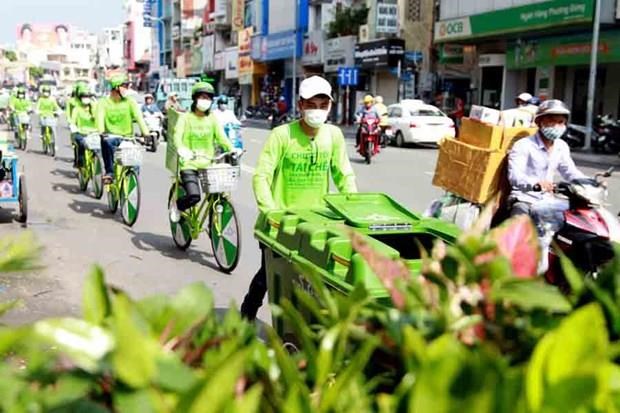Vietnamese businesses urged to join circular economy
Vietnamese businesses cannot stand outside the circular economy, especially in the context of global economic integration with commitments on ecological and environmental safety standards through free trade agreements, heard a conference on the theme in Ha Noi in early August.
 |
| Vietnamese volunteers collect waste on the streets to enhance public awareness. (Photo: VNA) |
A circular economy is an economic system combating pollution and achieving more sustainable development by reusing and recycling defunct products. Promoting the circular economy for enterprises requires active innovation, investment in modern technology, limiting energy consumption and using raw materials to produce output products capable of being recycled.
According to Mr Nguyen Quang Vinh, General Secretary of Viet Nam Chamber of Commerce and Industry (VCCI) and Vice Chairman of Viet Nam Business Council for Sustainable Development (VBCSD), the number of enterprises interested in innovation and the business model of circular economy has been increasing in the last three years.
However, Mr Vinh said the circular economy is still a new concept for many Vietnamese businesses, especially small and medium enterprises.
“The development of the circular economy in Viet Nam is posed as an indispensable need and must be implemented,” he said at the seminar.
Mr Vinh mentioned a study by Accenture Strategy, a multinational professional services company providing services in strategy, consulting, digital technology and operations, which revealed a circular economic model can open up market opportunities worth up to 4.5 trillion USD and create millions of jobs for the global economy by 2030.
“Many large corporations have been implementing the circular economy in their organisation,” he said.
However, the circular economy in Viet Nam is only popular at large enterprises.
For example, Unilever has a programme to collect and recycle plastic packaging and waste separation at source; and Coca Cola has a programme to collect and classify plastic bottles. The two companies are core members of the ‘Zero Waste to Nature’ initiative, a part of the Viet Nam Centre for Circular Economy hosted by VBCSD.
Executive Director of the US Business Council for Sustainable Development Andrew Thomas Mangan cited statistics that showed Viet Nam generated about 27 million tonnes of waste in 2015. Now up to 70 percent of waste treatment yards are not classified as hygienic burial sites.
To turn waste into valuable materials, Mangan said businesses face many difficulties, including controlling and building databases. Therefore, it is difficult for investors to access the raw materials resources as well as assessing and controlling information about raw materials in the country.
According to Mr Vinh, there have been a number of projects by scientists and domestic and foreign organisations deployed in Viet Nam to recycle plastic waste and contribute to promoting the circular economy, creating green production, green consumption and changing awareness of environmental protection in each individual.
“In order to promote the development of the circular economy, it is necessary to perfect the system of standards and regulations as a basis for waste recycling and the linkages among research institutes, universities, scientists and businesses,” Mr Vinh said.
At the macro level, Viet Nam has already had policies in place to facilitate the circular economy. In 2017, the Prime Minister also approved a project to develop Viet Nam's environment industry to 2025 in order to form an environment industry that can meet the contents of the circular economy.
The Ministry of Industry and Trade is currently drafting a National Action Programme on Sustainable Production and Consumption, which will be implemented in the period of 2021-30.
At the local level, HCM City has set a series of goals including reducing 60 percent of plastic bags by 2020 at supermarkets and trade centres and 50 percent in traditional markets.
Meanwhile, renewable energy and new energy will reach 1.7 percent of total energy capacity. At the same time, the relocation of pollution production facilities in residential areas is still ongoing.
(Source: VNA)